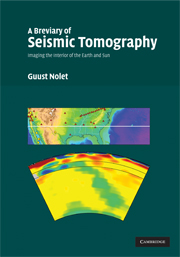Book contents
- Frontmatter
- Contents
- Preface
- 1 Introduction
- 2 Ray theory for seismic waves
- 3 Ray tracing
- 4 Wave scattering
- 5 Body wave amplitudes: theory
- 6 Travel times: observations
- 7 Travel times: interpretation
- 8 Body wave amplitudes: observation and interpretation
- 9 Normal modes
- 10 Surface wave interpretation: ray theory
- 11 Surface waves: finite-frequency theory
- 12 Model parametrization
- 13 Common corrections
- 14 Linear inversion
- 15 Resolution and error analysis
- 16 Anisotropy
- 17 Future directions
- References
- Author index
- General index
9 - Normal modes
Published online by Cambridge University Press: 24 January 2011
- Frontmatter
- Contents
- Preface
- 1 Introduction
- 2 Ray theory for seismic waves
- 3 Ray tracing
- 4 Wave scattering
- 5 Body wave amplitudes: theory
- 6 Travel times: observations
- 7 Travel times: interpretation
- 8 Body wave amplitudes: observation and interpretation
- 9 Normal modes
- 10 Surface wave interpretation: ray theory
- 11 Surface waves: finite-frequency theory
- 12 Model parametrization
- 13 Common corrections
- 14 Linear inversion
- 15 Resolution and error analysis
- 16 Anisotropy
- 17 Future directions
- References
- Author index
- General index
Summary
Since the Earth is a mechanical system with a well-defined boundary, the formal solution to the elastodynamic equations (2.3) with the boundary condition that the surface is stress-free yields a discrete spectrum of eigenfrequencies, just as is the case for a finite-length string in a violin. The reason that we have not taken this viewpoint earlier is that it is highly impractical for seismic tomography in the frequency band that is of most interest: above 10 mHz the number of eigenfrequencies in a small frequency band becomes very large. In addition, the spectral peaks are widened by the effects of attenuation and lateral heterogeneity and the discrete spectrum becomes, for all practical purposes, a continuous one because the peaks overlap. But below 10 mHz and even at higher frequency for some high Q modes it becomes feasible to measure individual eigenfrequencies (Figure 9.1).
The theoretical study of terrestrial eigenfrequencies started with the historical work of Love. Interest in the field really grew only after the first observations of normal modes, following the Chile earthquake of 1960. Major contributions to the development of the theory are by Pekeris et al., Backus and Gilbert, Dahlen, Gilbert, Woodhouse and Dahlen, Jordan and Park; and of the interpretation by Backus, Gilbert and Dziewonski, Jordan, Masters et al., Woodhouse and Girnius, Woodhouse and Dziewonski, Woodhouse and Wong.
- Type
- Chapter
- Information
- A Breviary of Seismic TomographyImaging the Interior of the Earth and Sun, pp. 158 - 177Publisher: Cambridge University PressPrint publication year: 2008



